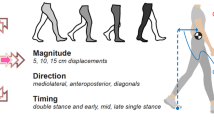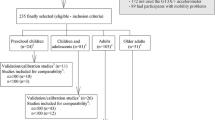Abstract
Body-worn kinematic sensors have been widely proposed as the optimal solution for portable, low cost, ambulatory monitoring of gait. This study aims to evaluate an adaptive gyroscope-based algorithm for automated temporal gait analysis using body-worn wireless gyroscopes. Gyroscope data from nine healthy adult subjects performing four walks at four different speeds were then compared against data acquired simultaneously using two force plates and an optical motion capture system. Data from a poliomyelitis patient, exhibiting pathological gait walking with and without the aid of a crutch, were also compared to the force plate. Results show that the mean true error between the adaptive gyroscope algorithm and force plate was −4.5 ± 14.4 ms and 43.4 ± 6.0 ms for IC and TC points, respectively, in healthy subjects. Similarly, the mean true error when data from the polio patient were compared against the force plate was −75.61 ± 27.53 ms and 99.20 ± 46.00 ms for IC and TC points, respectively. A comparison of the present algorithm against temporal gait parameters derived from an optical motion analysis system showed good agreement for nine healthy subjects at four speeds. These results show that the algorithm reported here could constitute the basis of a robust, portable, low-cost system for ambulatory monitoring of gait.






Similar content being viewed by others
References
Aminian K et al (2002) Spatio-temporal parameters of gait measured by an ambulatory system using miniature gyroscopes. J Biomech 35(5):689–699
Aminian K et al (2004) Evaluation of an ambulatory system for gait analysis in hip osteoarthritis and after total hip replacement. Gait Posture 20(1):102–107
Bland JM, Altman DG (1999) Measuring agreement in method comparison studies. Stat Methods Med Res 8(2):135–160
Burns A et al (2010) SHIMMER™—a Wireless sensor platform for non-invasive biomedical research. IEEE Sens 10(9):1527–1534
Burns A et al (2010) Open shareable research platform for developing interoperable personal health systems. In: 1st AMA-IEEE medical technology conference on individualized medicine, Washington, DC
Catalfamo P et al (2008) Detection of gait events using an F-Scan in-shoe pressure measurement system. Gait Posture 28(3):420–426
Cutti A et al (2010) ‘Outwalk’: a protocol for clinical gait analysis based on inertial and magnetic sensors. Med Biol Eng Comput 48(1):17–25
de Chazal P, Reilly RB (2006) A patient-adapting heartbeat classifier using ECG morphology and heartbeat interval features. IEEE Trans Biomed Eng 53(12):2535–2543
Ferraris F, Grimaldi U, Parvis M (1995) Procedure for effortless in-field calibration of three-axis rate gyros and accelerometers. Sens Mater 7(5):311–330
Frenkel-Toledo S et al (2005) Effect of gait speed on gait rhythmicity in Parkinson’s disease: variability of stride time and swing time respond differently. J Neuroeng Rehabil 31:2–23
Han J et al (2009) Adaptive windowing for gait phase discrimination in Parkinsonian gait using 3-axis acceleration signals. Med Biol Eng Comput 47(11):1155–1164
Hausdorff JM et al (1997) Altered fractal dynamics of gait: reduced stride-interval correlations with aging and Huntington’s disease. J Appl Physiol 82(1):262–269
Hreljac A, Marshall RN (2000) Algorithms to determine event timing during normal walking using kinematic data. J Biomech 33(6):783–786
Iasemidis LD et al (2003) Adaptive epileptic seizure prediction system. IEEE Trans Biomed Eng 50(5):616–627
Jasiewicz JM et al (2006) Gait event detection using linear accelerometers or angular velocity transducers in able-bodied and spinal-cord injured individuals. Gait Posture 24(4):502–509
Kotiadis D, Hermens HJ, Veltink PH (2010) Inertial gait phase detection for control of a drop foot stimulator: inertial sensing for gait phase detection. Med Eng Phys 32(4):287–297
Lorincz K et al (2007) Wearable wireless sensor network to assess clinical status in patients with neurological disorders. In: 6th International symposium on information processing in sensor networks
McGrath MJ, Dishongh TJ (2009) A common personal health research platform—SHIMMER™ and BioMOBIUS™. Intel Technol J 13(3):122–147
Miller A (2009) Gait event detection using a multilayer neural network. Gait Posture 29(4):542–545
Najafi B et al (2002) Measurement of stand-sit and sit-stand transitions using a miniature gyroscope and its application in fall risk evaluation in the elderly. IEEE Trans Biomed Eng 49(8):843–851
O’Connor CM et al (2007) Automatic detection of gait events using kinematic data. Gait Posture 25(3):469–474
O’Donovan KJ et al (2009) SHIMMER: a new tool for temporal Gait analysis. In: Proceedings of IEEE engineering in medicine and biology, Minneapolis, MN
Rangayyan RM (2002) Biomedical signal analysis. IEEE Press/Wiley, New York, NY
Sabatini AM et al (2005) Assessment of walking features from foot inertial sensing. IEEE Trans Biomed Eng 52(3):486–494
Salarian A et al (2004) Gait assessment in Parkinson’s disease: toward an ambulatory system for long-term monitoring. IEEE Trans Biomed Eng 51(8):1434–1443
Shrout PE, Fleiss JL (1979) Intraclass correlations: uses in assessing rater reliability. Psychol Bull 86(2):420–428
Tong K, Granat MH (1999) A practical gait analysis system using gyroscopes. Med Eng Phys 21(2):87–94
Zijlstra W, Hof AL (2003) Assessment of spatio-temporal gait parameters from trunk accelerations during human walking. Gait Posture 18(2):1–10
Acknowledgment
This research was completed as part of a wider programme of research within the TRIL Centre (Technology Research for Independent Living). The TRIL Centre is a multi-disciplinary research centre, bringing together researchers from UCD, TCD, NUIG, Intel, and GE Healthcare, funded by Intel, GE Healthcare and IDA Ireland (http://www.trilcentre.org). The authors would like to thank Dr. Emer Doheny for providing useful feedback on the manuscript as well as Mr. Ben Dromey for his help with graphically detailing the experimental layout.
Author information
Authors and Affiliations
Corresponding author
Rights and permissions
About this article
Cite this article
Greene, B.R., McGrath, D., O’Neill, R. et al. An adaptive gyroscope-based algorithm for temporal gait analysis. Med Biol Eng Comput 48, 1251–1260 (2010). https://doi.org/10.1007/s11517-010-0692-0
Received:
Accepted:
Published:
Issue Date:
DOI: https://doi.org/10.1007/s11517-010-0692-0




